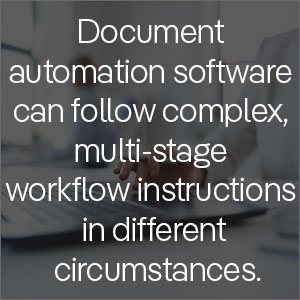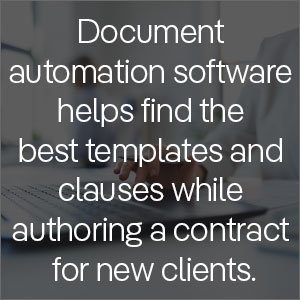Today, organizations of all sizes — and across all industries — are automating key business processes to make them better, quicker, and far less expensive. And given these business processes are represented or extended in the digital realm through documents, like contracts, invoices, and forms, technology such as document automation software can also assist companies in regulated industries to better comply with regulatory requirements.
The sheer volume and velocity of legal documents in the digital era make it simply impossible for humans to keep up with all of the activities related to unstructured content. So, it is no surprise that document automation systems — particularly those powered by artificial intelligence (AI) — are playing an increasingly vital role in processes like:
- Document creation
- Document extraction
- Workflow routing, filing, and enrichment
- Document application integration
- Document review and validation
Now, let’s look into the five stages of the document lifecycle, and explore how legal and other departments can meet their efficiency and compliance goals.
1. Document Automation Software – Creation and Capture
Consider for a moment the times when you needed to create a complex document like a contract. Without question, document assembly software can be the difference between creating a workable agreement quickly and struggling for hours — or even days — to create a document from scratch.
More specifically, AI-based document automation software helps you to find the best templates, clauses, and terms while authoring a contract for a new client, partner, employee, or acquisition target. This only accelerates document generation and improves the final product.
Also, by reusing pre-approved language, contract writers do not have to request thorough reviews from legal, finance, or other executive stakeholders. This pre-approved content minimizes the propensity for making errors or violating compliance standards while speeding up review and approval cycles.
2. Analytics and Extraction
Whether a legal document like a contract was born-digital or scanned from paper, extracting important data — such as author, creation date, start and end date, and information about parties to an agreement — is critical. It not only makes finding documents easier but also facilitates reporting.
Fortunately, document analytics help to identify contracts or statements of work related to audits, for example. It also helps legal and other departments better understand their contractual obligations and timelines. According to Gartner, about 50 percent of all supply chain organizations will soon invest in applications that support AI and advanced analytics.
It is important to note that ensuring all final documents are fully profiled with the right metadata requires the automated extraction of pre-selected information. Extraction might happen when a document is filed in a folder or when form fields are populated. In the case of scanned documents, this metadata — once indexed — is especially helpful for TIF or unprocessed PDF files.
Going forward, then, using document automation software for metadata creation and extraction will improve discoverability considerably and provide easy access to key document insights through reporting.
3. Workflows, Filing, and Enrichment
These days, business process management, workflow automation, and optimization are closely interrelated. Moving contracts or other documents between authors, departments, reviewers, and approvers can be done with a simple click of the mouse — to initiate them before moving through a multi-step routing process. A workflow can then be initiated when a document is filed in a designated folder. Or a document can be enriched with metadata with some automation scenarios.
In many cases, documents need to go through multiple reviews based on defined parameters. The good news is that intelligent document automation software can follow complex, multi-stage workflow instructions during normal circumstances. Or, pivot to alternate instructions in circumstances like an approver being absent.
Regulatory auditors also appreciate defined processes, and document workflow automation enforces policies like pricing or payment term approvals better than any “honor system” can. While manual workflow processes can create process bottlenecks and delays, automation only helps you to achieve the utmost efficiency.
4. Business Application Integration
Integrating document libraries and workflows with business applications serves to streamline business processes, mitigate data duplication, and add context to important documents like contracts. Making these particular documents accessible to those researching obligations to a customer or order specifications leads to deeper insights into business relationships. So, given corporate legal has significant oversight over document processes, the integration between a company’s legal tools and document and contract repositories simply makes good sense.
Also, adding digital signatures or other document automation software features, like OCR and ICR, to documents helps to improve the flow of documents from mobile devices and laptops to document repositories. This, while extracting user-inputted data for integrated business applications. The integrity of the data is then retained and made available to privileged users through their role-specific systems.
5. Review and Validation With Document Automation Software
Last but not least, AI-powered document review and validation take advantage of what technology does best: rapidly processing large amounts of data and identifying any anomalies. Automating reviews takes hours, days, or even weeks off of document review, negotiations, and approval validation. And as another function of AI, transparency around versioning and redlining enables companies to meet compliance requirements. Our Contract Risk and Compliance Datasheet can help your legal department gain deeper insight into every contract to make better-informed decisions.
So, is your company looking for ways to streamline business processes pertaining to sell-side, strategic sourcing, or operational contracts? To find out how ContractPodAi is using artificial intelligence to power document management processes globally, talk to a contract management expert today.
Author:

Sarvarth Misra
Connect with us on Linkedin











